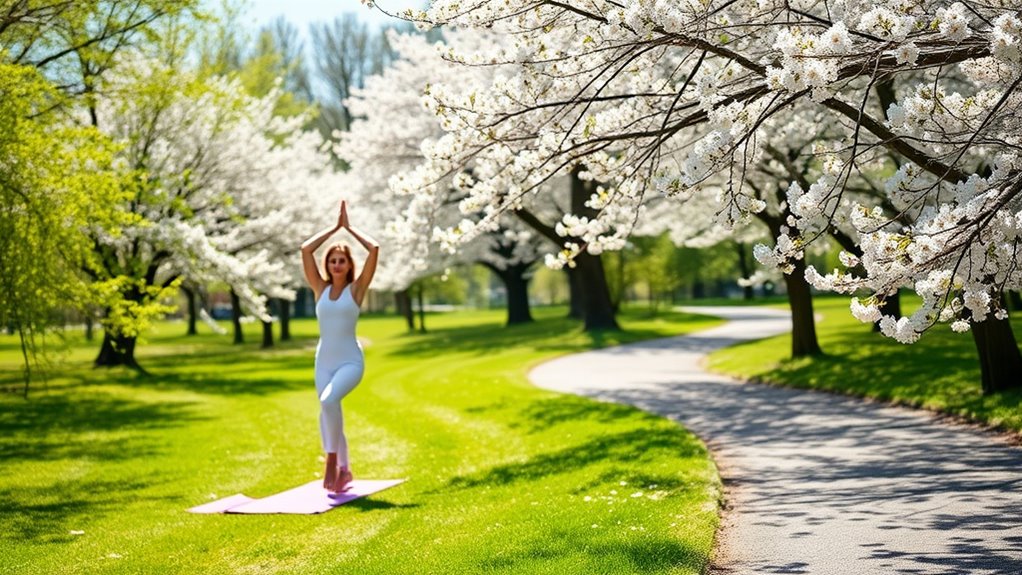To boost your mental health, try habit stacking by pairing mindfulness with movement throughout your day. You can do simple activities like mindful stretching, walking, or even during routine chores, focusing on your breath and bodily sensations. These small, manageable actions gradually build resilience, reduce stress, and improve focus. By consistently combining movement and mindfulness, you turn everyday moments into opportunities for calm and clarity—keep going to discover how to seamlessly incorporate this into your routine.
Key Takeaways
- Combine small movements like stretching or walking with mindfulness practices to promote mental calmness and physical health.
- Use routine activities, such as commuting or meal prep, to incorporate brief mindfulness moments easily.
- Focus on breath awareness and body sensations during movement to enhance emotional resilience and reduce stress.
- Gradually build habits by stacking mindful pauses onto existing daily actions for sustainable mental health benefits.
- Consistent pairing of movement and mindfulness creates long-term resilience, clarity, and emotional well-being.

If you want to improve your mental health without overhauling your daily routine, habit stacking offers a simple and effective strategy. By pairing small, manageable actions, you can build positive habits that support your well-being over time. One powerful approach involves combining mindfulness techniques with physical activity, creating a sustainable way to boost your mental clarity and emotional resilience. This pairing not only enhances your mood but also reinforces your ability to stay present and focused throughout the day.
When you integrate mindfulness techniques into your physical activity, you turn routine movement into an opportunity for mental grounding. For example, as you walk or stretch, you can focus on your breath, paying attention to each inhale and exhale. This practice helps you stay in the moment, reducing stress and anxiety. The physical activity benefits are amplified because movement naturally releases endorphins, the body’s feel-good chemicals, which improve your overall mood. Moving intentionally while practicing mindfulness creates a dual benefit: your body gets the physical benefits of exercise, and your mind gains clarity and calmness.
You don’t need to dedicate hours or to learn complicated techniques. Starting small, like taking a five-minute walk while focusing on your surroundings or doing gentle stretches while observing your breath, makes the process approachable. Over time, these small habits stack up, forming a routine that’s both easy to maintain and highly effective. The key is consistency—by linking mindfulness to activities you already do regularly, such as commuting or preparing meals, you can turn everyday moments into opportunities for mental health support.
This method also helps you develop a deeper awareness of your body and mind, which is central to many mindfulness techniques. As you become more attuned to your physical sensations and emotions during movement, you train your brain to respond more calmly to stressors. Additionally, understanding the importance of contrast ratio in visual clarity can deepen your appreciation for clarity and focus, both in your environment and within yourself. The physical activity benefits extend beyond mood enhancement; regular movement has been linked to better sleep, increased energy levels, and reduced symptoms of depression and anxiety. When you consciously pair mindfulness with movement, you create a cycle of positive reinforcement that fosters resilience and emotional stability.
Incorporating this habit stacking approach doesn’t require radical changes. You simply add mindfulness to movements you already do—like during your morning stretch or while waiting for your coffee to brew. Over time, these small adjustments can lead to significant improvements in your mental health. By consistently pairing mindfulness techniques with physical activity, you’re nurturing a more balanced, grounded you—one mindful moment at a time.
Frequently Asked Questions
How Long Should Each Mindfulness and Movement Session Last?
For habit consistency, aim for each mindfulness and movement session to last about 10 to 15 minutes. This duration is enough to reap mental health benefits without feeling overwhelming. If you’re new, start with shorter sessions and gradually increase as you build the habit. Consistency is key, so find a timeframe that fits into your daily routine, making it easier to stick with your habit over the long term.
Can Habit Stacking Work for Severe Mental Health Issues?
Habit stacking can help manage severe mental health issues, but severity considerations matter. You should work closely with a mental health professional to guarantee these routines complement therapy integration. While stacking habits like mindfulness and movement can boost your overall well-being, they shouldn’t replace treatment. Consistent, tailored efforts may improve your condition, but always prioritize professional guidance for severe challenges.
What if I Forget to Pair Mindfulness With Movement?
If you forget to pair mindfulness with movement, don’t worry. You can use mindfulness reminders or movement cues to help you remember. Set alarms or place sticky notes as visual prompts, and create specific triggers like starting your walk with a deep breath or a quick mindful check-in. Over time, these cues will become automatic, making it easier to integrate mindfulness and movement seamlessly into your routine.
Are There Specific Movements Best for Mental Health?
Surprisingly, not all movements are created equal for mental health. The best ones are gentle stretches and breathing exercises, which help calm your mind and reduce stress. Think slow, mindful movements that focus on your breath—like neck rolls, shoulder stretches, or deep breathing. These simple actions can boost your mood and mental clarity, proving that sometimes, the smallest movements pack the biggest mental health punch.
How Quickly Can I Expect to See Benefits From Habit Stacking?
You can start noticing benefits from habit stacking within a few weeks, but timing expectations vary based on consistency. As you consistently pair mindfulness with movement, observe progress indicators like improved mood, reduced stress, and increased energy. Keep in mind, regular practice enhances mental health gradually, so stay patient and committed. Over time, these small habits build up, leading to meaningful improvements in your overall well-being.
Conclusion
By stacking habits like mindfulness with movement, you’re weaving a vibrant tapestry of resilience and calm. Each small act becomes a brushstroke, painting a brighter, more resilient you. When these habits intertwine, they form a steady heartbeat—an anchor in life’s chaos. Embrace this gentle dance, and watch your mental health bloom like a resilient garden, rooted in care and consistency. Your journey to well-being starts now—one mindful step at a time.









